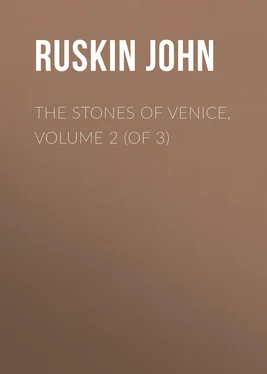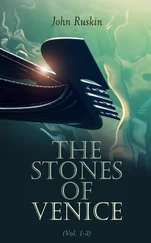John Ruskin - The Stones of Venice, Volume 2 (of 3)
Здесь есть возможность читать онлайн «John Ruskin - The Stones of Venice, Volume 2 (of 3)» — ознакомительный отрывок электронной книги совершенно бесплатно, а после прочтения отрывка купить полную версию. В некоторых случаях можно слушать аудио, скачать через торрент в формате fb2 и присутствует краткое содержание. Жанр: foreign_antique, foreign_home, architecture_book, literature_19, visual_arts, на английском языке. Описание произведения, (предисловие) а так же отзывы посетителей доступны на портале библиотеки ЛибКат.
- Название:The Stones of Venice, Volume 2 (of 3)
- Автор:
- Жанр:
- Год:неизвестен
- ISBN:нет данных
- Рейтинг книги:5 / 5. Голосов: 1
-
Избранное:Добавить в избранное
- Отзывы:
-
Ваша оценка:
- 100
- 1
- 2
- 3
- 4
- 5
The Stones of Venice, Volume 2 (of 3): краткое содержание, описание и аннотация
Предлагаем к чтению аннотацию, описание, краткое содержание или предисловие (зависит от того, что написал сам автор книги «The Stones of Venice, Volume 2 (of 3)»). Если вы не нашли необходимую информацию о книге — напишите в комментариях, мы постараемся отыскать её.
The Stones of Venice, Volume 2 (of 3) — читать онлайн ознакомительный отрывок
Ниже представлен текст книги, разбитый по страницам. Система сохранения места последней прочитанной страницы, позволяет с удобством читать онлайн бесплатно книгу «The Stones of Venice, Volume 2 (of 3)», без необходимости каждый раз заново искать на чём Вы остановились. Поставьте закладку, и сможете в любой момент перейти на страницу, на которой закончили чтение.
Интервал:
Закладка:
§ XXXIII. And this for another reason yet. Although, as we have said, it is impossible to cover the walls of a large building with color, except on the condition of dividing the stone into plates, there is always a certain appearance of meanness and niggardliness in the procedure. It is necessary that the builder should justify himself from this suspicion; and prove that it is not in mere economy or poverty, but in the real impossibility of doing otherwise, that he has sheeted his walls so thinly with the precious film. Now the shaft is exactly the portion of the edifice in which it is fittest to recover his honor in this respect. For if blocks of jasper or porphyry be inserted in the walls, the spectator cannot tell their thickness, and cannot judge of the costliness of the sacrifice. But the shaft he can measure with his eye in an instant, and estimate the quantity of treasure both in the mass of its existing substance, and in that which has been hewn away to bring it into its perfect and symmetrical form. And thus the shafts of all buildings of this kind are justly regarded as an expression of their wealth, and a form of treasure, just as much as the jewels or gold in the sacred vessels; they are, in fact, nothing else than large jewels, 31the block of precious serpentine or jasper being valued according to its size and brilliancy of color, like a large emerald or ruby; only the bulk required to bestow value on the one is to be measured in feet and tons, and on the other in lines and carats. The shafts must therefore be, without exception, of one block in all buildings of this kind; for the attempt in any place to incrust or joint them would be a deception like that of introducing a false stone among jewellery (for a number of joints of any precious stone are of course not equal in value to a single piece of equal weight), and would put an end at once to the spectator’s confidence in the expression of wealth in any portion of the structure, or of the spirit of sacrifice in those who raised it.
§ XXXIV. Law IV. The shafts may sometimes be independent of the construction. Exactly in proportion to the importance which the shaft assumes as a large jewel, is the diminution of its importance as a sustaining member; for the delight which we receive in its abstract bulk, and beauty of color, is altogether independent of any perception of its adaptation to mechanical necessities. Like other beautiful things in this world, its end is to be beautiful; and, in proportion to its beauty, it receives permission to be otherwise useless. We do not blame emeralds and rubies because we cannot make them into heads of hammers. Nay, so far from our admiration of the jewel shaft being dependent on its doing work for us, it is very possible that a chief part of its preciousness may consist in a delicacy, fragility, and tenderness of material, which must render it utterly unfit for hard work; and therefore that we shall admire it the more, because we perceive that if we were to put much weight upon it, it would be crushed. But, at all events, it is very clear that the primal object in the placing of such shafts must be the display of their beauty to the best advantage, and that therefore all imbedding of them in walls, or crowding of them into groups, in any position in which either their real size or any portion of their surface would be concealed, is either inadmissible altogether, or objectionable in proportion to their value; that no symmetrical or scientific arrangements of pillars are therefore ever to be expected in buildings of this kind, and that all such are even to be looked upon as positive errors and misapplications of materials: but that, on the contrary, we must be constantly prepared to see, and to see with admiration, shafts of great size and importance set in places where their real service is little more than nominal, and where the chief end of their existence is to catch the sunshine upon their polished sides, and lead the eye into delighted wandering among the mazes of their azure veins.
§ XXXV. Law V. The shafts may be of variable size. Since the value of each shaft depends upon its bulk, and diminishes with the diminution of its mass, in a greater ratio than the size itself diminishes, as in the case of all other jewellery, it is evident that we must not in general expect perfect symmetry and equality among the series of shafts, any more than definiteness of application; but that, on the contrary, an accurately observed symmetry ought to give us a kind of pain, as proving that considerable and useless loss has been sustained by some of the shafts, in being cut down to match with the rest. It is true that symmetry is generally sought for in works of smaller jewellery; but, even there, not a perfect symmetry, and obtained under circumstances quite different from those which affect the placing of shafts in architecture. First: the symmetry is usually imperfect. The stones that seem to match each other in a ring or necklace, appear to do so only because they are so small that their differences are not easily measured by the eye; but there is almost always such difference between them as would be strikingly apparent if it existed in the same proportion between two shafts nine or ten feet in height. Secondly: the quantity of stones which pass through a jeweller’s hands, and the facility of exchange of such small objects, enable the tradesman to select any number of stones of approximate size; a selection, however, often requiring so much time, that perfect symmetry in a group of very fine stones adds enormously to their value. But the architect has neither the time nor the facilities of exchange. He cannot lay aside one column in a corner of his church till, in the course of traffic, he obtain another that will match it; he has not hundreds of shafts fastened up in bundles, out of which he can match sizes at his ease; he cannot send to a brother-tradesman and exchange the useless stones for available ones, to the convenience of both. His blocks of stone, or his ready hewn shafts, have been brought to him in limited number, from immense distances; no others are to be had; and for those which he does not bring into use, there is no demand elsewhere. His only means of obtaining symmetry will therefore be, in cutting down the finer masses to equality with the inferior ones; and this we ought not to desire him often to do. And therefore, while sometimes in a Baldacchino, or an important chapel or shrine, this costly symmetry may be necessary, and admirable in proportion to its probable cost, in the general fabric we must expect to see shafts introduced of size and proportion continually varying, and such symmetry as may be obtained among them never altogether perfect, and dependent for its charm frequently on strange complexities and unexpected rising and falling of weight and accent in its marble syllables; bearing the same relation to a rigidly chiselled and proportioned architecture that the wild lyric rhythm of Æschylus or Pindar bears to the finished measures of Pope.
§ XXXVI. The application of the principles of jewellery to the smaller as well as the larger blocks, will suggest to us another reason for the method of incrustation adopted in the walls. It often happens that the beauty of the veining in some varieties of alabaster is so great, that it becomes desirable to exhibit it by dividing the stone, not merely to economize its substance, but to display the changes in the disposition of its fantastic lines. By reversing one of two thin plates successively taken from the stone, and placing their corresponding edges in contact, a perfectly symmetrical figure may be obtained, which will enable the eye to comprehend more thoroughly the position of the veins. And this is actually the method in which, for the most part, the alabasters of St. Mark are employed; thus accomplishing a double good,—directing the spectator, in the first place, to close observation of the nature of the stone employed, and in the second, giving him a farther proof of the honesty of intention in the builder: for wherever similar veining is discovered in two pieces, the fact is declared that they have been cut from the same stone. It would have been easy to disguise the similarity by using them in different parts of the building; but on the contrary they are set edge to edge, so that the whole system of the architecture may be discovered at a glance by any one acquainted with the nature of the stones employed. Nay, but, it is perhaps answered me, not by an ordinary observer; a person ignorant of the nature of alabaster might perhaps fancy all these symmetrical patterns to have been found in the stone itself, and thus be doubly deceived, supposing blocks to be solid and symmetrical which were in reality subdivided and irregular. I grant it; but be it remembered, that in all things, ignorance is liable to be deceived, and has no right to accuse anything but itself as the source of the deception. The style and the words are dishonest, not which are liable to be misunderstood if subjected to no inquiry, but which are deliberately calculated to lead inquiry astray. There are perhaps no great or noble truths, from those of religion downwards, which present no mistakeable aspect to casual or ignorant contemplation. Both the truth and the lie agree in hiding themselves at first, but the lie continues to hide itself with effort, as we approach to examine it; and leads us, if undiscovered, into deeper lies; the truth reveals itself in proportion to our patience and knowledge, discovers itself kindly to our pleading, and leads us, as it is discovered, into deeper truths.
Читать дальшеИнтервал:
Закладка:
Похожие книги на «The Stones of Venice, Volume 2 (of 3)»
Представляем Вашему вниманию похожие книги на «The Stones of Venice, Volume 2 (of 3)» списком для выбора. Мы отобрали схожую по названию и смыслу литературу в надежде предоставить читателям больше вариантов отыскать новые, интересные, ещё непрочитанные произведения.
Обсуждение, отзывы о книге «The Stones of Venice, Volume 2 (of 3)» и просто собственные мнения читателей. Оставьте ваши комментарии, напишите, что Вы думаете о произведении, его смысле или главных героях. Укажите что конкретно понравилось, а что нет, и почему Вы так считаете.












